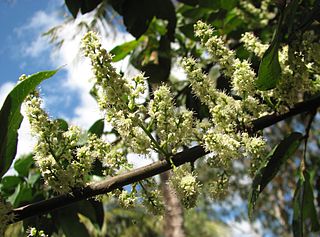
Guioa is a genus of about 78 rainforest tree species known to science, which constitute part of the plant family Sapindaceae. They have a wide distribution, ranging from throughout Malesia, in Burma, Cambodia, Vietnam, Thailand, Malay Peninsula, Borneo, Sumatra, Philippines, Java, Flores, Timor, Sulawesi, Moluccas, New Guinea, further southwards through the east coast of Queensland and New South Wales, Australia and further eastwards to the Pacific Islands, including Tonga, New Caledonia, Fiji and Samoa.
This article is a list of biological species, subspecies, and evolutionary significant units that are known to have become extinct during the Holocene, the current geologic epoch, ordered by their known or approximate date of disappearance from oldest to most recent.
Ficus aripuanensis is a species of plant in the family Moraceae.
Ficus blepharophylla is a species of fig tree in the family Moraceae.
Ficus calyptroceras is a species of fig in the family Moraceae, in Brazil.
Ficus hirsuta is a species of plant in the family Moraceae. It is endemic to Brazil.
Ficus mexiae is a species of fig in the family Moraceae, native to Brazil.
Ficus luschnathiana is a species of plant in the family Moraceae. It is found in Argentina, Brazil, Paraguay, and Uruguay.
Ficus mutabilis is a species of plant in the family Moraceae. It is endemic to New Caledonia.
Ficus pakkensis is a species of plant in the family Moraceae, native to tropical northern South America.
Ficus ramiflora is a species of fig tree in the family Moraceae.
Ficus roraimensis is a species of fig tree in the family Moraceae.
Ficus salzmanniana is a species of fig tree in the family Moraceae, native to Brazil.

Ficus trigonata is a species of tree in the family Moraceae. It is native to North America and South America.

Ficus velutina is a species of plant in the family Moraceae. It is found in Brazil and Costa Rica.
Helicostylis heterotricha is a species of plant in the family Moraceae. It is endemic to Brazil.
Perebea glabrifolia is a species of plant in the family Moraceae. It is endemic to Brazil.

The World's 25 Most Endangered Primates is a list of highly endangered primate species selected and published by the International Union for Conservation of Nature (IUCN) Species Survival Commission (SSC) Primate Specialist Group (PSG), the International Primatological Society (IPS), Global Wildlife Conservation (GWC), and Bristol Zoological Society (BZS). The IUCN/SSC PSG worked with Conservation International (CI) to start the list in 2000, but in 2002, during the 19th Congress of the International Primatological Society, primatologists reviewed and debated the list, resulting in the 2002–2004 revision and the endorsement of the IPS. The publication was a joint project between the three conservation organizations until the 2012–2014 list when BZS was added as a publisher. The 2018–2020 list was the first time Conservation International was not among the publishers, replaced instead by GWC. The list has been revised every two years following the biannual Congress of the IPS. Starting with the 2004–2006 report, the title changed to "Primates in Peril: The World's 25 Most Endangered Primates". That same year, the list began to provide information about each species, including their conservation status and the threats they face in the wild. The species text is written in collaboration with experts from the field, with 60 people contributing to the 2006–2008 report and 85 people contributing to the 2008–2010 report. The 2004–2006 and 2006–2008 reports were published in the IUCN/SSC PSG journal Primate Conservation,, since then they have been published as independent publications.
This page is based on this
Wikipedia article Text is available under the
CC BY-SA 4.0 license; additional terms may apply.
Images, videos and audio are available under their respective licenses.




